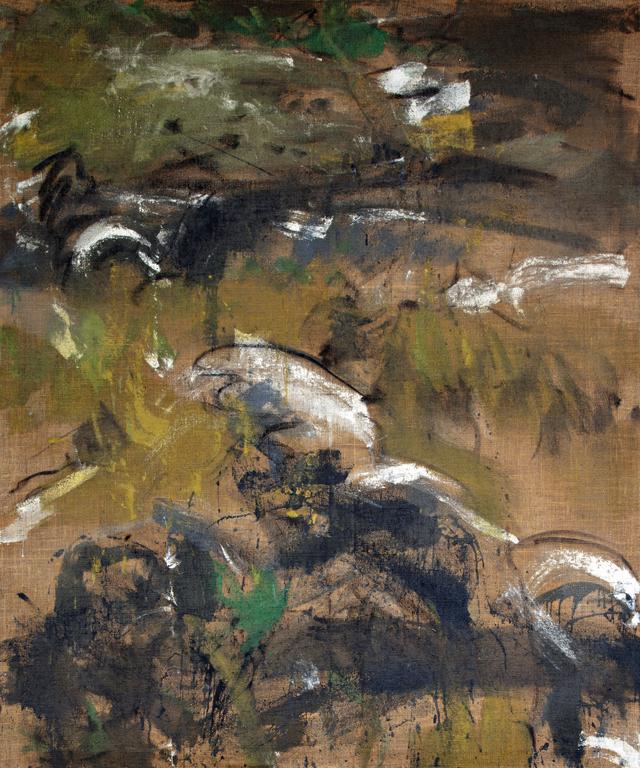Bernd Koberling: Berg Boden, Entstehungsdatum unbekannt (Mountain Ground, date of origin unknown)

Synthetic resin, jute, 145 x 180 cm
Berg Boden is from the series "Jute Paintings", which Koberling produced between 1974 and 1982. Already in his previous creative phase ("Language and Landscape", 1972 to 1973) had he been occupied with the representation of landscapes, which he now - as in "Berg Boden" - captured on jute, a material that was new to him. The series "Jute Paintings" comprises two different groups of motifs: on the one hand flowers and buds, on the other hand geological themes such as lava formations or the ground of a mountain ("Berg Boden"). In the mid-1970s, he created his "Bergboden" and "Sumpfloch" paintings, in which he turned away from the (lateral) view of nature to a top view (= view of things in miniature). This change of perspective is also linked to his new tendency to interpret natural details more strongly rather than landscape panoramas, which he continued in the 1990s.
Bernd Koberling (*1938 in Berlin, Germany) grew up in post-war Berlin. Today he lives and works there and in Iceland. Bernd Koberling learned to be a cook and earned his living in the catering trade in his early years. At the same time, he realized his dream and studied painting at the Academy of Fine Arts in Berlin from 1958 to 1960. Together with others, he founded the neo-expressionist artist group "Vision" and belonged - like Hödicke and Lüpertz (who are also shown at the academy) - to the first artists' self-help gallery Großgörschen 35. This gallery was an experiment and one of the first self-help galleries ever, and the godfather of further such projects. The young painters wanted to set an example against the rigid established art business.
Bernd Koberling quickly became successful: he taught painting at the University of Fine Arts in Hamburg and at the University of the Arts in Berlin. In the 1980s, he became particularly well known as one of the "fathers" of the Neue Wilden - bright colors on large-format canvas, painting as if in a frenzy of color, became their trademark. However, this is only a part of his comprehensive oeuvre, which was created over a period of more than 60 years. His art goes back to Abstract Expressionism. He worked in different phases with picture series, which show the change in his interpretation and perception of his motifs. In addition to the turbulent life in the city, he sought more and more peace and untouched nature in northern Sweden, the mountains of Lapland and Iceland, where he spent about 40 years of his life at times. Both were both a place of rest and a source of inspiration to him, so that the depiction of nature and landscape in its many facets was to become the main theme of his works.